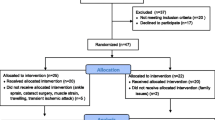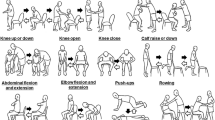Abstract
Purpose
This study investigated the effect of 12 weeks of mat Pilates intervention (60 min sessions, three times per week) on lower limb rate of force development (RFD) parameters (absolute and relative values and contractile impulse) in physically active and overweight elderly women.
Methods
Fourteen elderly women (age 62 ± 3 years) participated in this study. Workouts were performed in three sets; repetitions increased every 4 weeks, and exercise difficulty increased from beginner to intermediate and advanced levels. Knee extensor and hip extensor–flexor RTD parameters were measured at different time intervals (0–30, 0–50, 0–100, 0–150, 0–200, and 0–250 ms) before (weeks − 4 and 0, control period) and after 6 and 12 weeks of mat Pilates intervention.
Results
No statistical difference (p > 0.05) was observed between weeks − 4 and 0 (control period). However, significant increments were observed after week 12 for most time intervals for absolute and relative knee extensor and hip extensor–flexor RFD, as well as for contractile impulse for the same muscle groups.
Conclusions
We conclude that the mat Pilates causes significant increments in knee extensor and hip extensor–flexor RFD and contractile impulse using an incremental structure of training in physically active elderly women.


Similar content being viewed by others
References
Yu F, Hedström M, Cristea A et al (2007) Effects of ageing and gender on contractile properties in human skeletal muscle and single fibres. Acta Physiol 190:229–241. https://doi.org/10.1111/j.1748-1716.2007.01699.x
Mitchell WK, Williams J, Atherton P et al (2012) Sarcopenia, dynapenia, and the impact of advancing age on human skeletal muscle size and strength; a quantitative review. Front Physiol 3:1–18. https://doi.org/10.3389/fphys.2012.00260
Narici MV, Maffulli N, Maganaris CN (2008) Ageing of human muscles and tendons. Disabil Rehabil 30:1548–1554. https://doi.org/10.1080/09638280701831058
Narici MV, Maganaris CN, Reeves ND, Capodaglio P (2003) Effect of aging on human muscle architecture. J Appl Physiol 95:2229–2234. https://doi.org/10.1152/japplphysiol.00433.2003
Newman AB, Lee JS, Visser M et al (2005) Weight change and the conservation of lean mass in old age: the health, aging and body composition study. Am J Clin Nutr 82:872–878. https://doi.org/10.1093/ajcn/82.4.872
Kuk JL, Saunders TJ, Davidson LE, Ross R (2009) Age-related changes in total and regional fat distribution. Ageing Res Rev 8:339–348. https://doi.org/10.1016/J.ARR.2009.06.001
Santanasto AJ, Glynn NW, Newman MA et al (2011) Impact of weight loss on physical function with changes in strength, muscle mass, and muscle fat infiltration in overweight to moderately obese older adults: a randomized clinical trial. J Obes. https://doi.org/10.1155/2011/516576
LaRoche DP, Cremin KA, Greenleaf B, Croce RV (2010) Rapid torque development in older female fallers and nonfallers: a comparison across lower-extremity muscles. J Electromyogr Kinesiol 20:482–488. https://doi.org/10.1016/J.JELEKIN.2009.08.004
Doherty TJ (2003) Invited review: aging and sarcopenia. J Appl Physiol 95:1717–1727. https://doi.org/10.1152/japplphysiol.00347.2003
Thompson BJ, Ryan ED, Herda TJ et al (2014) Age-related changes in the rate of muscle activation and rapid force characteristics. Age (Dordr) 36:839–849. https://doi.org/10.1007/s11357-013-9605-0
Aagaard P, Simonsen EB, Andersen JL et al (2002) Increased rate of force development and neural drive of human skeletal muscle following resistance training. J Appl Physiol 93:1318–1326. https://doi.org/10.1152/japplphysiol.00283.2002
Caserotti P, Aagaard P, Larsen JB, Puggaard L (2008) Explosive heavy-resistance training in old and very old adults: changes in rapid muscle force, strength and power. Scand J Med Sci Sports 18:773–782. https://doi.org/10.1111/j.1600-0838.2007.00732.x
Barboza BHV, Gurjão ALD, Jambassi Filho JC et al (2008) Age-related decline on rate of force development and the effect of resistance training in older women. Acta Fisiátrica 16:4–9
Moura BM de, Sakugawa RL, Orssatto LBR da et al (2017) Functional capacity improves in-line with neuromuscular performance after 12 weeks of non-linear periodization strength training in the elderly. Aging Clin Exp Res 1–10. https://doi.org/10.1007/s40520-017-0873-x
Tiggemann CL, Dias CP, Radaelli R et al (2016) Effect of traditional resistance and power training using rated perceived exertion for enhancement of muscle strength, power, and functional performance. Age (Dordr) 38:42. https://doi.org/10.1007/s11357-016-9904-3
Blazevich AJ, Horne S, Cannavan D et al (2008) Effect of contraction mode of slow-speed resistance training on the maximum rate of force development in the human quadriceps. Muscle Nerv 38:1133–1146. https://doi.org/10.1002/mus.21021
Souza MS, Vieira BC, C (2006) Who are the people looking for the Pilates method? J Bodyw Mov Ther 10:328–334. https://doi.org/10.1016/J.JBMT.2005.10.005
Wells C, Kolt GS, Bialocerkowski A (2012) Defining Pilates exercise: a systematic review. Complement Ther Med 20:253–262. https://doi.org/10.1016/j.ctim.2012.02.005
Oliveira LC, Oliveira RG, Pires-Oliveira DAA (2016) Comparison between static stretching and the Pilates method on the flexibility of older women. J Bodyw Mov Ther 1–7. https://doi.org/10.1016/j.jbmt.2016.01.008
Rogers K, Gibson AL (2009) Eight-week traditional mat Pilates training-program effects on adult fitness characteristics. Res Q Exerc Sport 80:569–574
Oliveira LC, Pires-Oliveira DAA, Abucarub AC, Oliveira RG De et al (2017) Pilates increases isokinetic muscular strength of the elbow flexor and extensor muscles of older women: a randomized controlled clinical trial. J Bodyw Mov Ther 21:2–10. https://doi.org/10.1016/j.jbmt.2016.03.002
Bertoli J, Dal Pupo J, Vaz MA et al (2018) Effects of mat Pilates on hip and knee isokinetic torque parameters in elderly women. J Bodyw Mov Ther 22:798–804. https://doi.org/10.1016/J.JBMT.2017.08.006
Kloubec J (2011) Pilates: how does it work and who needs it? Muscles Ligament Tendons J 1:61–66
Aagaard P (2003) Training-induced changes in neural function. Exerc Sport Sci Rev 31:61–67
Higbie EJ, Cureton KJ, Warren GL, Prior BM (1996) Effects of concentric and eccentric training on muscle strength, cross-sectional area, and neural activation. J Appl Physiol 81:2173–2181. https://doi.org/10.1152/jappl.1996.81.5.2173
Avelar BP, Costa JNA de, Safons MP et al (2016) Balance exercises circuit improves muscle strength, balance, and functional performance in older women. Age (Dordr) 38:14. https://doi.org/10.1007/s11357-016-9872-7
Dvir Z (2002) Isokinetic of the hip muscles. In: Isokinetics: muscle testing, interpretation, and clinical applications, pp 91–100
Neumann D (2010) Kinesiology of the hip: a focus on muscular actions. J Orthop Sports Phys Ther 40:82–94. https://doi.org/10.2519/jospt.2010.3025
Skelton DA, Greig CA, Davies JM, Young A (1994) Strength, power and related functional ability of healthy people aged 65–89 years. Age Ageing 23:371–377
Cohen J (1992) A power primer. Psychol Bull 112:155–159
Brucki SMD, Nitrini R, Caramelli P et al (2003) Sugestões para o uso do mini-exame do estado mental no Brasil. Arq Neuropsiquiatr 61:777–781. https://doi.org/10.1590/S0004-282X2003000500014
Folstein MF, Robins LN, Helzer JE (1983) The mini-mental state examination. Arch Gen Psychiatry 40:812. https://doi.org/10.1016/0022-3956(75)90026-6
Yesavage JA, Sheikh JI (1986) 9/ Geriatric Depression Scale (GDS) sigeriatric depression recent evidence and development of a shorter version. Clin Gerontol ISSN 5:165–173. https://doi.org/10.1300/J018v05n01
Häkkinen K, Newton RU, Gordon SE et al (1998) Changes in muscle morphology, electromyographic activity, and force production characteristics during progressive strength training in young and older men. J Gerontol A Biol Sci Med Sci 53:415–423
Häkkinen K, Kallinen M, Izquierdo M et al (1998) Changes in agonist-antagonist EMG, muscle CSA, and force during strength training in middle-aged and older people Changes in agonist-antagonist EMG, muscle CSA, and force during strength training in middle-aged and older people. J Appl Physiol 84:1341–1349
Latey P (2002) Updating the principles of the Pilates method—part 2. J Bodyw Mov Ther 6:94–101. https://doi.org/10.1054/jbmt.2002.0289
Walker S, Peltonen H, Sautel J et al (2014) Neuromuscular adaptations to constant vs. variable resistance training in older men. Int J Sports Med 35:69–74. https://doi.org/10.1055/s-0033-1343404
Maffiuletti NA, Aagaard P, Blazevich AJ et al (2016) Rate of force development: physiological and methodological considerations. Eur J Appl Physiol 116:1091–1116. https://doi.org/10.1007/s00421-016-3346-6
Cohen J (1988) Statistical power analysis for the behavioral sciences, 2nd edn. Lawrence Erlbaum Associates, New York
Thompson BJ, Ryan ED, Sobolewski EJ et al (2013) Age related differences in maximal and rapid torque characteristics of the leg extensors and flexors in young, middle-aged and old men. Exp Gerontol 48:277–282. https://doi.org/10.1016/j.exger.2012.10.009
Izquierdo M, Aguado X, Gonzalez R et al (1999) Maximal and explosive force production capacity and balance performance in men of different ages. Eur J Appl Physiol Occup Physiol 79:260–267. https://doi.org/10.1007/s004210050504
Bellumori M, Jaric S, Knight CA (2013) Age-related decline in the rate of force development scaling factor. Mot Control 17:370–381
Klass M, Baudry S, Duchateau J (2008) Age-related decline in rate of torque development is accompanied by lower maximal motor unit discharge frequency during fast contractions. J Appl Physiol 104:739–746. https://doi.org/10.1152/japplphysiol.00550.2007
Thelen DG, Muriuki M, James J et al (2000) Muscle activities used by young and old adults when stepping to regain balance during a forward fall. J Electromyogr Kinesiol 10:93–101
Reinders I, Murphy RA, Koster A et al (2015) Muscle quality and muscle fat infiltration in relation to incident mobility disability and gait speed decline: the age, gene/environment susceptibility-Reykjavik study. J Gerontol A Biol Sci Med Sci 70:1030–1036. https://doi.org/10.1093/gerona/glv016
LaRoche DP, Kralian RJ, Millett ED (2011) Fat mass limits lower-extremity relative strength and maximal walking performance in older women. J Electromyogr Kinesiol 21:754–761. https://doi.org/10.1016/j.jelekin.2011.07.006
Folland JP, Buckthorpe MW, Hannah R (2014) Human capacity for explosive force production: neural and contractile determinants. Scand J Med Sci Sports 24:894–906. https://doi.org/10.1111/sms.12131
Bassey EJ, Fiatarone MA, O’Neill EF et al (1992) Leg extensor power and functional performance in very old men and women. Clin Sci 82:321–327
Andersen LL, Aagaard P (2006) Influence of maximal muscle strength and intrinsic muscle contractile properties on contractile rate of force development. Eur J Appl Physiol 96:46–52. https://doi.org/10.1007/s00421-005-0070-z
D’Antona G (2003) The effect of ageing and immobilization on structure and function of human skeletal muscle fibres. J Physiol 552:499–511. https://doi.org/10.1113/jphysiol.2003.046276
Foldvari M, Clark M, Laviolette LC et al (2000) Association of muscle power with functional status in community-dwelling elderly women. J Gerontol A Biol Sci Med Sci 55:M192–M199
Behm DG, Drinkwater EJ, Willardson JM, Cowley PM (2010) The use of instability to train the core musculature. Appl Physiol Nutr Metab 35:91–108. https://doi.org/10.1139/H09-127
Acknowledgements
The authors wish to thank the study participants, CAPES for the scholarship for JB, and CNPq for the fellowship for FD and MAV.
Author information
Authors and Affiliations
Corresponding author
Ethics declarations
Conflict of interest
The authors of this manuscript declare no conflict of interest.
Ethical approval
The local Human Research Ethics Committee approved the study (Protocol No. 44972915.9.0000.0110), procedures were conducted in accordance with the Declaration of Helsinki, and the participants signed an informed consent form.
Additional information
Publisher’s Note
Springer Nature remains neutral with regard to jurisdictional claims in published maps and institutional affiliations.
Electronic supplementary material
Below is the link to the electronic supplementary material.
Rights and permissions
About this article
Cite this article
Bertoli, J., Diefenthaeler, F., Detanico, D. et al. Can mat Pilates intervention increase lower limb rate of force development in overweight physically active older women?. Sport Sci Health 15, 407–415 (2019). https://doi.org/10.1007/s11332-019-00533-5
Received:
Accepted:
Published:
Issue Date:
DOI: https://doi.org/10.1007/s11332-019-00533-5




